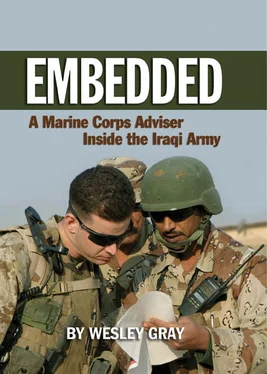We waded through the crowds of Arabs to find the lounge. We all looked forward to settling into the posh Kellogg Brown and Root (KBR) lounge. The company’s lounge rooms are what a Department of Defense (DoD) employee needs after flying around the world. They come complete with a fifty-inch flat screen television playing the latest DVDs and rows of luscious leather lounge chairs.
Just as we were sinking into our lounge chairs, Major Pyle walked in. “Gentlemen, we have a 0500 flight to Baghdad International Airport tomorrow. Buses are heading here now to take us to the Kuwait transient camp. When they get here, grab your trash, and get ready to move.” Unmotivated, we all acknowledged the boss with “Roger.”
Hell is hot… Kuwait is even hotter. Up until this point we hadn’t left an air-conditioned space in Kuwait. As Adams and I went rushing outside of the KBR lounge to get on the bus, the heat slammed us in the face. Even in the middle of the night, it felt as if someone was blowing a hair dryer into our faces. “Good God,” I murmured under my breath as heat blanketed my body. I have been in some scorching areas of the United States, yet nothing compares to Kuwait. In America, you can witness 120-degree heat in the Southwest, but it will be a “dry heat.” In Florida, it can reach 100 degrees and it will be a “humid heat.” Well, in Kuwait, it is 140 degrees and it is a “fucking hot heat.”
When people ask me about Kuwait when I return home, I thought, my response will be that Kuwait is Kuwait. A large, flat desert with oil refineries and oil operations as far as the eye can see, tons of immigrant labor, and some world-class heat. I hoped that the only other time I would visit Kuwait in my lifetime would be during the return trip out of Iraq.
We landed at Baghdad International Airport, commonly called BIOP (I’m not sure why the U.S. Army decided to use the acronym BIOP and not BIAP). The aircrew lowered the rear cargo door on the C-130 and the brilliant light of Iraq pierced the cabin. We immediately woke up and untangled ourselves from the netting of the C-130 that was acting as our seats.
Watching the cargo door fall to the ground, I wondered if rounds would start flying past us. Before this my only memorable images of Iraq involved bullets and explosions. As a first timer into a combat zone, my visions of Iraq were based more on the movie Terminator 2: Judgment Day than reality. Fortunately, we were on the most secure base on the planet—Camp Victory.
Camp Victory is the U.S. Army’s crowning achievement in base construction. The base exemplifies the Army’s ability to fortify an enormous piece of earth and, at the same time, convince the Iraqi people beyond any doubt that we are here to stay for a long time. One step into the camp and it was hard for me to imagine we would be leaving Iraq any time in the next century, let alone the next few years. Not only was it huge, but it was surprisingly posh. Even the tents in the transient field quarters had outstanding amenities: air-conditioning, a floor-cleaning service, and wireless Internet. In addition to the stellar amenities in the tents, there were KBR chow halls with delicious food and enormous exercise facilities everywhere. I did not feel as though I was in Iraq. In truth I felt as if the C-130 had taken a wrong turn and landed at a Club Med in the middle of the desert somewhere. Things were looking up.
Despite the surprising comforts of Camp Victory, the place took the wind out of my sails. When I landed in Iraq, I was prepared to walk in the footsteps of the combat Marines who fought famous battles in Belleau Wood, Guadalcanal, Iwo Jima, and Okinawa. But in the midst of Camp Victory luxury, my epic vision of being a hard-charging, leather-tough combat Marine vanished.
Camp Victory had a few telltale signs that reminded me we were in Iraq. First, large blimps flew above the camp—the same airships you see flying above NFL stadiums on Sundays. Not surprisingly these aircraft have a different purpose in Iraq. The blimps over Camp Victory were there to pinpoint enemy mortar locations when terrorists decided to launch them into the base.
Another sign we were in Iraq: everyone at Camp Victory carried loaded weapons. After witnessing the caliber of the people who carried the weapons—typically overweight U.S. Army, National Guard, and U.S. Air Force personnel—my biggest fear was not dealing with a terrorist who managed to get through twenty-five layers of camp security but an Air Force airman who negligently discharged his weapon.
The most surprising detail I noticed around Camp Victory was that the place was filled with civilians. It seemed like Halliburton had taken over Iraq. I had been under the impression I would be surrounded by military personnel, but it seemed there were more civilians there. I wanted to kick myself for not buying Halliburton stock and the stock of other defense contractors at the beginning of the war. That trade would have been like taking candy from a baby.
Transient tent life was good. I met many interesting folks. People say Disneyland is a great place for people watching; I would argue that the transient tents at Camp Victory provide the best people watching in the world. There are hardened combat vets on their way out of Iraq (half of whom are mentally warped), “fresh meat” coming into Iraq, Filipino and Nepalese housekeepers who keep the place clean, and an assortment of civilian contractors who do a range of things from cleaning shitters to managing multimillion dollar engineering projects.
From what I observed in the transient tents, there was a high correlation between motivation level and time spent in Iraq. As one would expect, those who had just arrived in Iraq were full of piss and vinegar, whereas those who had been there for a long time were typically pissed and smelled like vinegar. An Army sergeant put it best when I asked him about life around camp. “Sir,” he said, “when I got here I was excited about the additional combat pay. Now that I’ve been here eight and half months, been in numerous IED [improvised explosive device] attacks, and haven’t had sex in a long time, I can’t wait to get the fuck out of this place.”
The evening after we landed we got our first small taste of the difference between camping at Yellowstone and camping at Camp Victory—mortar attacks. The attacks were nowhere near our tents, but I could still hear the rumble and feel the small earthquakes beneath me as the shockwaves moved across the ground. What I learned about mortar attacks is that you can’t worry about them because you can’t do anything to stop them.
I did some simple calculations to figure out how improbable it was to get whacked by a mortar on Camp Victory. My back-of-the-envelope calculations were based on the camp being six square miles, the mortar attacks being randomly distributed around the camp, and there being concrete barriers and sandbags everywhere. First, a six-by-six-mile area is roughly one billion square feet. Next, let us assume one of the average mortars the insurgents fling into the camp has a kill radius of about a thousand square feet, after we take into account all blast protection measures in place around camp. When you use this simple model you end up with literally a one-in-a-million chance (1000/1,000,000,000 ≈ 1/1,000,000) of having a mortar land close enough to kill you at Camp Victory.
Is a one-in-a-million chance a big deal? I remember reading a statistic somewhere that every year a nontrivial percentage of Americans are injured while trying bizarre sexual positions. I liked my chances with the mortars. If I died from a mortar attack at Camp Victory, I reasoned, at least my wife would get four hundred thousand dollars from the military’s life insurance fund, I would be buried in Arlington Cemetery, and I would be awarded a Purple Heart. This all sounded better than the alternative: “Kama Sutra gone extremely wrong.”
Читать дальше












